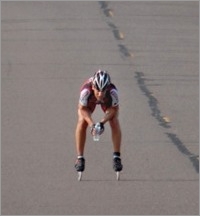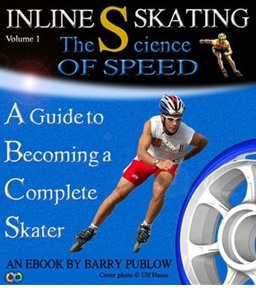 | ||
| ||||||||
Going Down ... the big hill at the Big Granite Inline Marathon in Ashland, WI. By Barry Publow For die-hard speed freaks, going down a steep hill can be exhilarating. But for skaters who lack balance and confidence it can be a virtual nightmare. Two questions often come up at my SpeedCamp workshops: "How do I go fast and maintain control?" and "What do I do if I find myself going too fast?" Several factors are important when you're rolling downhill at speed: Surface Traction Downhill skaters spend a considerable amount of time testing wheels and selecting the ones which give them the best combination of traction and speed. And they often prefer to use new wheels for each run down the course. Even a slightly worn set of wheels (at high speeds) will not have the same properties as new ones. According to Todd Gormick of Hyper Wheels, most skaters prefer to use wheels which have been skated on just enough to remove the "mohawk" — the thin raised strip of urethane on the center of new wheels. "Trueness" At high speeds, even slight misalignments in the shape of the wheel or hub can cause major problems. This is largely responsible for the much dreaded "speed wobble," which many skaters encounter on steep downhills. Bent frames can also cause problems. Naturally, skate manufacturers do their best to ensure the trueness and safety of their products. But at 40-plus mph, imperfections are magnified. Aerodynamics In motorsports, downforce is a critical factor. Simply put, it's the flow of air pushing against the ground. In Formula-1 racing, the front and rear wings are adjusted to vary the level of downforce. Downforce is less of an issue in skating because speeds are lower. But it's still an issue. To maximize downforce while skating, assume a deeply-seated position with the head and shoulders slightly lower than the hips. In theory, the greater the difference in height between the shoulders and hips, the greater the downforce. Failure to assume this aerodynamic position could result in the opposite effect, and — in some cases — result in catastrophe. Exposing a large portion of your trunk and chest to the open air increase air resistance and downforce. If you want to go fast, avoid this "parachute" position and keep your head and shoulders as low as possible. Stability
Being stable on your skates is always important, but never more so than when you're flying downhill. The key is tensed relaxation — staying relatively relaxed while consciously contracting your muscles to stabilize your key joints (ankle, knee and trunk). Going downhill is like being blindfolded and expecting, at any moment, to be pushed from an unknown direction. You never know what is going to happen, so you have to be ready for anything. That means adoping a defensive posture with your body low and your core muscles engaged. But don't get too tense. That will only tire you out and make it harder to deal with whatever the hill throws at you. (Check back in a couple weeks when Barry explains what to do when you find yourself going too fast.) ...
• Buy "Inline Skating: The Science of Speed" Related reading: • Skate Tip of the Week Archive
...
Copyright © 2007 Inline Planet | ||||||

 Barry Publow is an world renowned coach, educator and writer. He is the author of "Speed on Skates," as well as the newly-released eBook, "Inline Skating: The Science of Speed." Since 1995, he has published more than 100 sport-specific technical and training articles. He is also an accomplished athlete. He is a former national inline team member and Canadian record holder, and has competed at both the World Championships and Pan American Games, placing as high as fifth. He is also the 2005 U.S and North American Marathon Speedskating Champion in both 25 km and 50km events.
Barry Publow is an world renowned coach, educator and writer. He is the author of "Speed on Skates," as well as the newly-released eBook, "Inline Skating: The Science of Speed." Since 1995, he has published more than 100 sport-specific technical and training articles. He is also an accomplished athlete. He is a former national inline team member and Canadian record holder, and has competed at both the World Championships and Pan American Games, placing as high as fifth. He is also the 2005 U.S and North American Marathon Speedskating Champion in both 25 km and 50km events.
